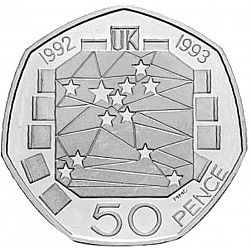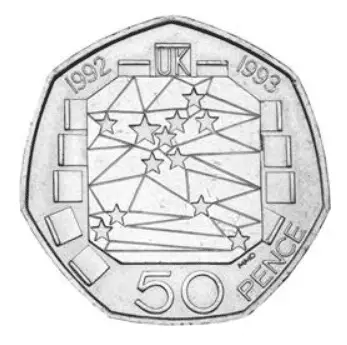The Single 1992 Market 50p is a highly valuable 50p, but how much does it sell for today?
On average, a circulated Single Market 50p sells for between £30 and £60, but graded specimens can be much more valuable and proof versions even more so.
If you want to learn more about this coin, including what makes it so valuable and what other versions of it exist, then you’ve come to the right place.
Single Market 50p Mintage
Only 109,000 of these coins were released into circulation, which is the smallest mintage of any 50p ever issued into circulation.
Is The Single Market 50p Rare?
With a mintage of just 109,000, the Single Market 50p is extremely rare.
In fact, it is the rarest 50p that you can find. Although, you won’t be able to find this coin in your change as it was removed from circulation in 1998 when the ‘old-style 50p’ coins with larger diameter were replaced with the smaller 50p that we know today.
It’s quite interesting to compare this coin to the Kew Gardens 50p, which is the rarest 50p in current circulation with a mintage of 210,000. The Kew Gardens 50p is much more valuable despite having a larger mintage, and sells for an average of £148.
Other Versions Of The Coin
As with most commemorative coins, the 1992 Single Market 50p was issued in uncirculated varieties for coin collectors, and these have been summarised in the table below:
| Version | Mintage |
| Brilliant Uncirculated | 135,366 |
| Proof First Day Cover | 62,326 |
| Silver Proof First Day Cover | 26,890 |
| Silver Proof Piedfort First Day Cover | 10,993 |
| Gold Proof First Day Cover | 1,864 |
All 50p coins issued in 1992 were this commemorative type coin as opposed to the Seated Britannia. The uncirculated and proof mint sets, however, had both versions.
The design was re-issued in 2009 as a Non-Circulating Legal Tender coin to mark the 40th anniversary of the 50 Pence coin denomination.
The Design Of The 1992 Single Market 50p Coin
The coin is part of the 50 pence design with a 7-sided shape that forms an equilateral curved heptagon which has been minted since 1969. The shape is sometimes called a Reuleaux polygon which is a curve of constant width leaving the diameter of the coin with a consistent measurement regardless of the bisection you measure.

The Obverse features the Queen’s portrait by Raphael David Maklouf in which the Queen wears the George IV State Diadem. The image shows a crowned bust of Queen Elizabeth II facing right. It is sometimes referred to as the Third Portrait.
The reverse of the 1992 Single Market 50p coin shows a representation of a table on which 12 stars are placed. The stars are linked by a network of lines to connect the stars and the 12 surrounding chairs that are seated around the table.
One of the chairs has the letters the UK on it. The dates 1992 and 1993 are to the left and right top outer rims. Centred below at the very bottom of the design is the number 50.
At an angle to the right side of the outer rim is the word PENCE. The designer’s initials MMD, Mary Milner Dickens, are seen just below the table to the right above the letter “E” in PENCE.
The Designer Of The 1992-1993 50p Coin
Mary Milner Dickens was the designer of this special commemorative coin. It was her first coin design. She was known as a sculptor.
Her design was chosen again in 2000 to commemorate the 150th anniversary of the Public Libraries Act. She also designed the crown of 2001 marking the centenary of the death of Queen Victoria. Additionally, she designed the 50p of 2003 for the centenary of the foundation of the Women’s Social and Political Union.
She was also commissioned to design medals including the emotive Battle of Britain 50th Anniversary medal of 1990 and the Royal Mint’s Fleur de Coin Club medal in 1994.
What Does The 1992 Single Market 50p Coin Represent?
It had been almost 20 years between the first and the second special commemorative 50p coin designs. The first was in 1973 which celebrated the European Economic Community EEC. Once again, the 50p would celebrate links with Europe, but this time it would mark the UK’s entry into the single market.
The connecting lines between the stars and the 12 chairs around the table represent the countries of Europe working together.
Sometimes, this coin is referred to as the 1992-1993 Fifty Pence Pence Coin – Single Market because of the dual date printed on the reverse. This 50p coin was issued to commemorate the United Kingdom’s Presidency of the European Community and the completion of the Single European Market.
During the second half of 1992, the United Kingdom held the Presidency of the European Community. The Single European Market came into effect on January 1, 1993.
As a forerunner of the current EU, the coin was to celebrate the Presidency of the Council of European Community Ministers and the completion of the single market.
